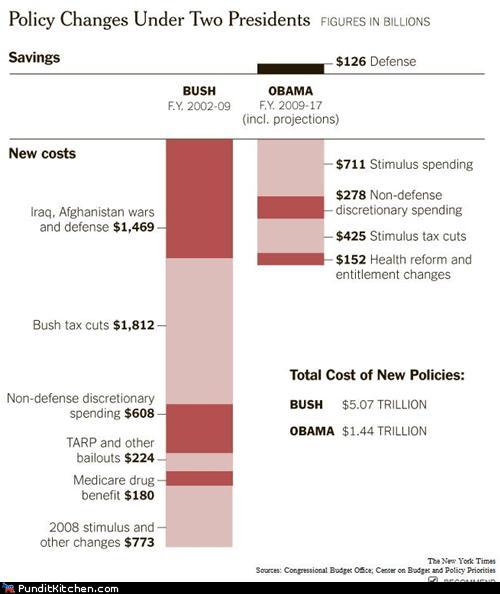
Cost of Obama’s Policies vs. Bush’s Policies
Source; Congressional Budget Office and Center on Budget and Policy Priorites
A solution for Universal Health Care
There is no reason we could not have “Socialized” Health Care (instead of it’s true meaning – Universal Health Care,) have it cheaper, and allow it to serve all people, AND still have the ability to bypass the “Lifetime Cap” that so many people are afraid of. It does mean that all sides would have to make sacrifices though, plus the Insurance and Health Care Industries would have to undergo some major changes.
Step One would be to Nationalize ONE major Insurance Carrier. This company would have a cap of 6.5% profit margin. They would operate independently of the US Government, but would answer to Congress, the Judicial Branch, and it’s investors. The 6.5% Profit margin is below high risk funds, but slightly above most medium risk funds making it a good company for larger funds to invest in. The company would have as it’s mandate to reduce costs as long as it is not at the expense of the care their clients would receive. Their secondary goals would be 99% customer satisfaction, 5% or less waste, 90% Employee Satisfaction, and client processes that are as simple as possible. This means Bonuses, company perks, benefits, etc – you want the place to be a happy place to work which means happy and productive workers who in turn give good service to the clients.
Step Two would be to mandate health care upon everyone. Companies would still contribute to Health Insurance just like they do now, and would need to include part time employees in the plan. I would allow them the ability to only need to pay 75% of the cost of a full time employee for the part timers though so it would still be cost effective to have part time employees in certain situations. Although I would not allow the number of part time employees exceed more then one half of the number of full time employees unless special circumstances warranted it.
Step Three would be to put a cap on Doctors earnings, I’d still make it fairly high to make the industry attractive. In return they would be exempt from general malpractice suits, although they would still be liable for gross negligence. I would make it easier for Doctors to consult with each other, including a national database (and forums!) of illnesses and diseases, their symptoms and a step by step regime for each one. Controls would be put in place to allow doctors to step outside of that regime when needed – probably a peer review committee randomly selected of doctors and retired doctors within the local geographic area. Doctors would also need to go through a periodic re-examination. The test would include mental abilities, skills, and face to face behaviors. It would also be partially dependent on their patients treatments, recoveries, and happiness with the doctor in general.
Step Four: Give the FDA more power to analyze and enforce Food and Drug quality controls and tests. They would also have the ability to fast track promising new drugs and greater ability to use human volunteers. The FDA would also have the power to price control drugs, making it cheap enough to be cost effective for general use.
Step Five: Drug and Medical Supply Companies. As above, I’d Nationalize one of each industry. The goals would be the same, with the same profit margins, employee bonuses, etc. Drug Companies would not be allowed to give gifts to doctors and such would be as tightly controlled as campaign donations are for politicians. (Or more so.) Companies would still be allowed to patent and license technologies, plus sell their own house brands of common medications.
Step Six: Consumers/Patients would be able to purchase additional insurance to hedge against costs that went over the lifetime cap – I think most people are saying $3 million lifetime. The exact finances would have to be worked out, but say you want to go to a five million lifetime cap. You’d have to add say $1.5 million to a general fund that is only payable upon your death, or upon your reaching the $3 million dollar cap. Excess monies in the fund at your death would be inherited, taxed at a slightly lower rate (to encourage starting the fund in the first place,) but would only go into your inheritors own fund. Half the interest on the fund would go to the company that administrats these funds and the other half would go back into the fund itself. The companies would only be allowed to reinvest the money in low and medium risk ventures as determined under supervison of the SEC, but would be liable for any decreases of more then 10% over the life of the fund. IE – if a person puts in $1 million dollars over their lifetime, but the funds value decreases to $500,000 the company would be liable for the missing $500,000.
Individual Users would be able to get a .05% tax break per a year that they’re able to see a Doctor for regular check ups. They would also be able to get another .05% tax break once every ten years, providing they either make significant changes to their health (significant weight loss, stop smoking, etc), or maintain within 15% of the recommended standards as approved by a doctor. To qualify for this, they would simply need to have an annual physical/checkup every two years.
There is still a lot more to it, but I believe that this would be an extremely effective system, provide health care for all and answer all the issues people have with Universal Health Care, yet not give up too many individual rights and freedoms.